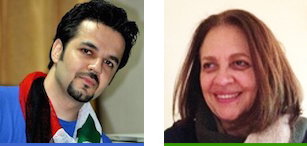Introduction
Every city is, among other things, a rich repository of stories. The Aleppo Memory Map attempts to capture some of Aleppo's stories, allowing listeners to explore what the city means to those who know it best. Click on a marker, and a short audio file pops up: a memory of summers spent playing with cousins, or of poetry readings at a neighborhood church. The map contains no images, attempting instead to paint a verbal portrait of the city as seen through the eyes of its citizens. In doing so, it aims to capture some of the pride and affection that Aleppans feel for their city.
Those of us who know Aleppo only through casualty lists and the grim litany of bombings will discover glimpses of a very different city: memories of teenage flirtations, of a favorite bookstore, of playing chess at a cafe outside the Citadel. Those who know Aleppo well may find reminders of the places they love -- or stumble upon totally unfamiliar corners of the city. So whether you come to the map as a stranger to Aleppo or as a native, take some time to listen to its stories. They provide a rich and personal set of views of the city -- a way of remembering what Aleppo was like in the years before the war.
Interviewees
 The map is grounded in the memories of Ahmad Beetar (left) and Rim Mghir (right).
The map is grounded in the memories of Ahmad Beetar (left) and Rim Mghir (right).Ahmad grew up in Aleppo in the 1980s and 1990s, attending school and building a career as a journalist. He is the founder of Eye on Aleppo, a website that promotes cultural and artistic events in Aleppo. He left Syria in 2012 after receiving threats from both the regime and rebel forces. He now lives in Washington, DC, where he works as a freelance translator; most of his family remains in Aleppo. The memories he contributed to the map include stories of his childhood home, the Red Crescent, the Nablus Girls' School, the Citadel, and the St. Terez Church.
Rim grew up in Idlib in the 1960s and 1970s. Every summer, she and her cousins would visit their grandparents in Aleppo -- where, she claims, they were "the naughtiest kids in the neighborhood!" She later moved to Aleppo herself to attend medical school at the University of Aleppo, where she specialized in psychiatry. Rim left Syria after graduation to do her residency in the US, and has lived in the Washington, DC area ever since. She visited Aleppo frequently during the 1990s and 2000s, until the current conflict made such visits impossible. The memories Rim contributed to the map include stories of her grandmother's home, the medical school, the Tawleed hospital for women, her aunt's medical clinic on al-Tillal street, her favorite spots in al-Azizieh neighborhood, and the souks of the old city.
On the map, green markers denote Rim's memories and blue markers denote Ahmad's memories
The Memory Map
To see a larger version of the map in a separate tab, click here.The Memories
The memories embedded in the Aleppo Memory Map are the product of several hours of conversation with Rim and Ahmad. Both were asked to prepare by selecting 4-6 sites meaningful to them; in the interviews, each marked their sites on the map and spoke about each site for as long as they wished. These stories have been edited for clarity and concision in order to produce the final map. The goal was to pare each story down to its essential core -- ideally less than three minutes in length -- so that visitors to the map can easily listen to multiple memories in one sitting.
Central to this editing process was an attempt to retain the sound of Rim and Ahmad's natural speech -- so you'll hear plenty of pauses, stammers, and unfinished sentences. In many cases, these verbal tics are central to the emotional heft of the speaker's words. Rim's memory of her grandmother's house, for instance, would not be nearly as compelling without her laughter; Ahmad's memory of the Citadel wouldn't be as powerful without his hesitant groping for words. By relying on the actual audio -- rather than written transcripts -- the Memory Map makes these emotional responses more vividly available to its audience.
Future Directions
The map as it currently exists is a pilot project, one that's expected to evolve and develop. Collecting and adding more memories would be an obvious next step. In particular, adding memories narrated in Arabic -- and perhaps other languages of Syria -- would make the project more accessible to both listeners and to potential contributors. A future version of the map might even incorporate a sorting functionality, so that viewers would be able to display only stories narrated in languages they speak.
Another possible direction would be to rework the map to reflect particular individuals' mental maps of Aleppo. The current map is static; though viewers can zoom in and out and examine different areas, the map itself does not change. But what if, when you began to listen to the audio, the map itself shifted to reflect the speaker's view of the city? Perhaps some parts of the city would go dark, while others would be illuminated. Or perhaps some parts of the city would shrink, while others would expand. Regardless of how, exactly, the change was visually represented, the point would be to map the city as it looks from the speaker's perspective. Reworking the project in this vein would further emphasize the subjective character of the map, matching the aural experience of listening to the memories with a similarly subjective visual experience.
This project was created by
Produced by Jess Engebretson, a graduate student in English and Comparative Literature, for Conflict Urbanism: Aleppo seminar at Columbia University during Spring 2016. Questions, suggestions, and ideas can be directed to her at this address. See all student work
here .
